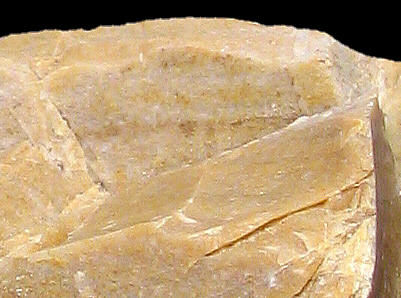
Foto: Jehanne Féblot-Augustins, 2005.
- Col du mont Clergeon
- Sous-Sac
Sampled sites:
| Material name: | Ht2 |
| Synonyms: | N/A |
| Material (geologic): | Lower Cretaceous (Late Hauterivian) flint |

Foto: Jehanne Féblot-Augustins, 2005. |
Sampled sites:
|
| Mode of occurrence: | Extensive continuous, but tectonised, beds, ranging in thickness between 8 and 25 cm; occurs in secondary context as angular and generally non-cortical fragments. |
| Cortex: | Rough, reddish yellow, 1 cm, transition sharp to gradual. |
| Colour: | Light brownish grey (10YR 6/2 to 6/3) to grey (10YR 7/1). |
| Pattern: | Faintly or more distinctly laminated (layers 1 mm thick). |
| Appearance: | Mediocre and tectonised material, dull and opaque, quite rough, medium-grained. |
| Structure: | Laminated with variations in colour due to a differential impregnation by iron oxides, fluidal arrangement of grains. |
| Texture: | Wackestone/packstone. |
| Matrix: | Translucent. |
| Grains: | 40 to 50 %, milky or stained yellow, subangular with high (100 to 200 µ) to low sphericity (max. 750 µ), or irregularly shaped. |
| Grain composition: | Very numerous thick-walled sponge spicules recrystallized as chalcedony, a few serpulids, cone-shaped biserial foraminifera (Textularidae); peloids, traces of glauconite and of iron oxides. |
| Further information: | Click here for the original French description (opens in a new window), or here for more information on the attributes used in the description (use your browser's "BACK"-button to return here). |
| Citing: | Information on citing this page can be found here. |
| Locality: | Moye / Col du mont Clergeon, France, Haute-Savoie department. |
| Synonyms: | Sampling site Bugey 46 after Féblot-Augustins |
| Geographical description: | The flint was collected at the highest point of the ridge of Mont Clergeon, near the D 55 road. |
| Geographical co-ordinates: |
east/x 875,3 north/y 2100,8 (Lambert zone II, NTF)
This corresponds roughly with |
| Co-ordinate precision: |
The coordinates given were taken from a topographical map, and are within 50 metres of the precise position. The latitude/longitude coordinates are a direct transformation of these data on WGS84 and are within the same margin of error. The location can be found on the 1:25 000 topographical map sheet 3332 OT of the French Institut Géographique National. |
| Geology: |
According to the geological map, the substrate consists of sediments of Late Hauterivian age, belonging to unit n3. Map of all sampled localities of Lower Cretaceous flint in the Bugey (PDF, 300 KB, opens in new window). |
| Type of source: | Primary. |
| Other types of flint: | Apart from Ht2, no other flints are known from this location. |
thumb.jpg) Foto: Jehanne Féblot-Augustins, 2005 |
thumb.jpg) Foto: Jehanne Féblot-Augustins, 2005 |
| Locality: | Injoux-Génissiat / Sous-Sac , France, Ain department |
| Synonyms: | Sampling site Bugey 50 after Féblot-Augustins |
| Geographical description: | The source is located in a wooded valley with an intermittent stream near the Grotte des Huguenots, about half-way between the villages of Craz and Lhôpital, roughly eight kilometres south-southwest of Bellegarde-sur-Valserine. |
| Geographical co-ordinates: |
east/x 866 north/y 2120,3 (Lambert zone II, NTF)
This corresponds roughly with |
| Co-ordinate precision: |
The Lambert-coordinates above were read off a large-scale map, and are within approx. 50 metres of the actual spot. The latitude/longitude coordinates are a direct transformation of these data on WGS84 and are accurate to the same level, so don't be deceived by the apparently high precision to the second. The location can be found on the 1:25 000 topographical map sheet 3330 W of the French Institut Géographique National. |
| Geology: |
The sample was collected from the surface where the local gological map indicates sediments of Barrmo-Aptian of Urgoninian facies (unit n4-5), although the flint itself is most likely of Hauterivian age. Map of all sampled localities of Early Cretaceous flint in the Bugey (PDF, 300 KB, opens in new window). |
| Type of source: | Secondary. |
| Other types of flint: | Apart from the Ht2-type, also flints belonging to the Ht3 type can be found around here. |
thumb.jpg) Foto: Jehanne Féblot-Augustins, 2005 |
| Last modified on: November 15, 2005 |
Contents primarily by: Jehanne Féblot-Augustins |
Comments to: |